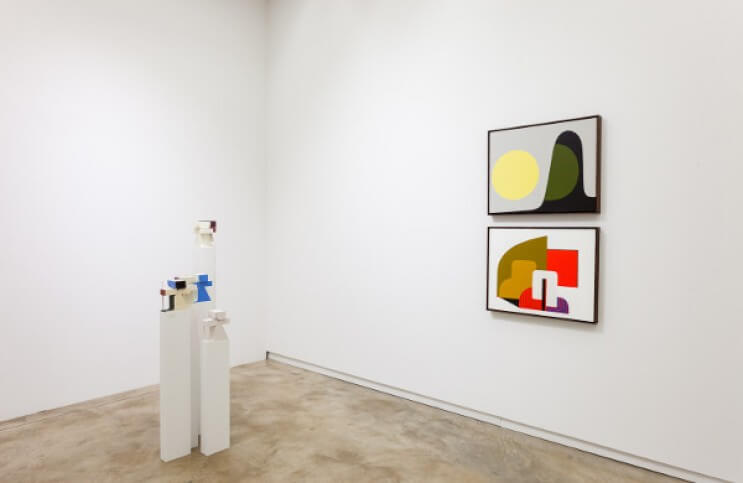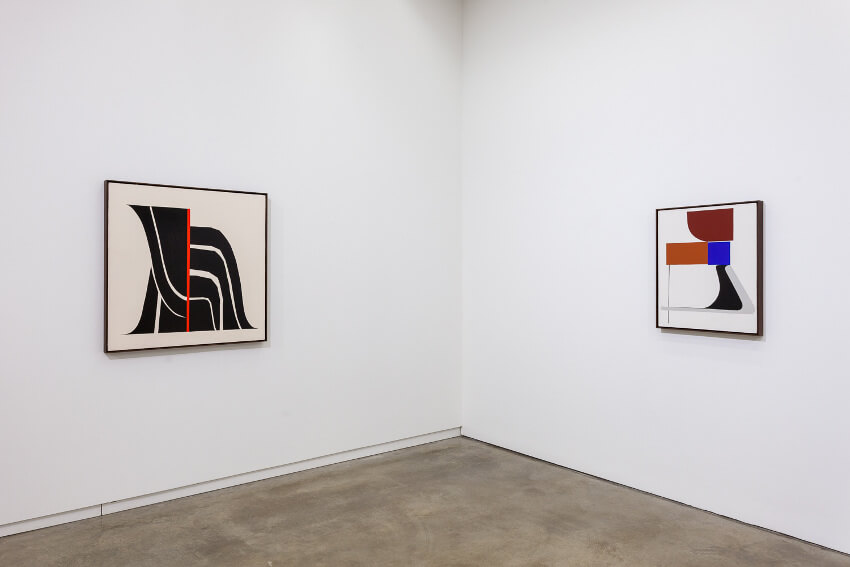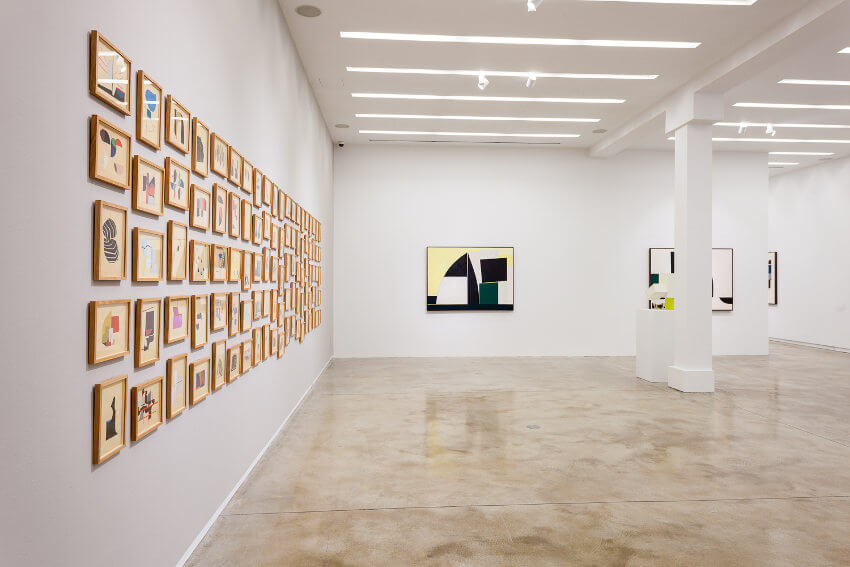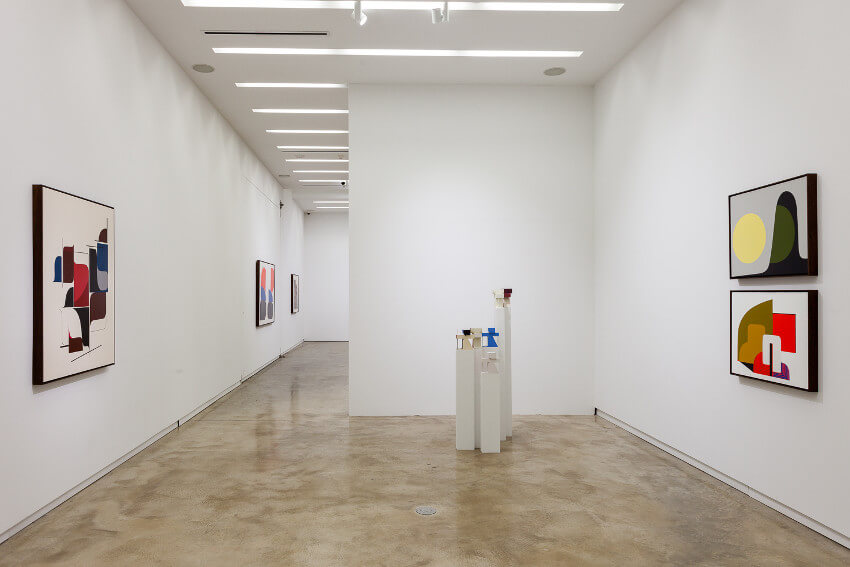
Clare Rojas’ New Solo Show Egret Merges Abstraction and Story
In Egret, her new solo exhibition at Kavi Gupta gallery in Chicago, Clare Rojas challenges one of the basic misconceptions about abstract art—that non-objective images cannot tell stories. The term “narrative art” means art that conjures up some kind of a tale—like a painting of a commonly known literary scene, or a sculpture of heroic figures from history. Obviously, if an artist wants to convey a story to viewers, the simplest way is to use recognizable images of familiar beings doing familiar things. But imagine trying to tell even the simplest of stories using unrecognizable images of previously unknown forms strewn about in abstract space, or hovering in a void. Few artists can accomplish this difficult feat. In Egret, Rojas manages it with help from her eerily humane, and undeniably comforting personal language of shapes. Not exactly geometric, and not exactly organic, her pictures occupy a middle ground between concretion and abstraction—or maybe between being and becoming. Rojas developed this visual language from a sort of aesthetic zero point she discovered in her daily drawing practice: she refers to it as her “totemic form,” something that resembles an amalgam of a drop of water, a flower petal, and a ski slope. She first discovered this form while engaged in a sort of automatic drawing exercise—she was doodling and it just presented itself. Rojas recognized it as something oddly universal. She returned to it day after day, experimenting to see what else it might become. Although the form is purely abstract, Rojas began seeing hints of it in the concrete world—in nature, in the bodies of other people, or in architectural elements of the built environment. That form is recognizable in each of the more than 100 new works Rojas created for Egret, and it is at the heart of what makes me feel like when I look at these new works I am part of a story.
A Mature Aesthetic Vision
Most people who are familiar with the work of Clare Rojas know the artist from her association with the Mission School, the influential San Francisco street art movement that exploded into a global phenomenon in the late 1990s, culminating in the 2008 documentary film Beautiful Losers. Though she was a relative late-comer to the movement, her talent as a painter, disciplined studio schedule, and natural predilection for its D.I.Y., folk-skate-and-surf inspired aesthetic quickly made Rojas one of the most accomplished artists in the group. Today her work can be found in the permanent collections of some of the most important museums in the United States, including MoMA, the Whitney Museum of American Art, and The Walker Art Center.

Clare Rojas - Egret, solo show at Kavi Gupta Gallery, Chicago, IL. 2018, installation view. © Clare Rojas, courtesy of Kavi Gupta
But while many of her contemporaries amongst the Beautiful Losers focused on developing firmly established visual brands (picture the work of Shepard Fairey), Rojas remained dedicated to experimentation. In addition to making visual art she nurtured a successful music career, performing extensively and releasing eight LPs under her stage name Peggy Honeywell. And rather than sticking doggedly to the figurative folk art vibe that initially brought her global recognition, Rojas pushed herself beyond those choices for which she was already known. Her intrepidness is what made this extraordinary new body of work possible. Its maturity, conceptual rigor, and extraordinary level of craft signals Rojas has grown far beyond her Mission School roots.

Clare Rojas - Egret, solo show at Kavi Gupta Gallery, Chicago, IL. 2018, installation view. © Clare Rojas, courtesy of Kavi Gupta
Pictures of Heritage and Abundance
The images and objects on view in Egret dwell outside the realm of expectation. What makes them seem familiar to me is not that they are explicitly figurative—it is more that the images have an anthropomorphic presence. The compositions do not tell clear stories, but rather the relationships at play within them hint at an underlying narrative. The forms and shapes float in space, like the cast off characters of some epic, salt-of-the-earth ballad that, although new, seems hauntingly recognizable. These works almost seem mystical. And the magic is particularly evident in the sculptural pieces Rojas created for the show. One grouping of sculptures in particular—a collection of six tall, skinny, rectangular wooden posts topped with painted, three-dimensional manifestations of her aforementioned totemic form—struck me as a sort of Rosetta Stone for the rest of the show. Quasi-geometric, oozingly biomorphic, and seductively human-looking, this group of sculptures presents itself like a talisman—a visual and metaphysical guide towards understanding what the rest of the show wants to share.

Clare Rojas - Egret, solo show at Kavi Gupta Gallery, Chicago, IL. 2018, installation view. © Clare Rojas, courtesy of Kavi Gupta
When I spoke with Rojas about this feeling, she seemed to know exactly what I was talking about. She referenced the “human will towards story,” or the need people have to identify with images even when they are abstract. Our brains are intrinsically wired to obsess over our own personal narratives. The myth of who we are and what our future might be is related directly to how we contextualize every image and object we encounter. This is why different cerebral zones activate in our brains when we look at something we recognize than when we look at something abstract. Rojas' new work strangely, and pleasantly, bridges that gap. It exists outside of the realm of what my brain has words to easily describe, yet it “incites,” as Rojas says, a sort of memory; as if I am looking at pictures of distant family. Whether other viewers will feel what I feel when looking at this new body of work Rojas has created, I cannot say. But one thing is clear: the work is dynamic, idiosyncratic and unexpected—fresh is a good word. It conveys a distinctive and joyful visual language that has a nuanced heritage with the place from whence Rojas came, but it is also unique to this artist at this moment, and hints at something abundant yet to come. Clare Rojas: Egret is on view at Kavi Gupta, 219 N. Elizabeth Street, Chicago, IL, through 7 July 2018.
Featured image: Clare Rojas - Egret, solo show at Kavi Gupta Gallery, Chicago, IL. 2018, installation view. © Clare Rojas, courtesy of Kavi Gupta
By Phillip Barcio






